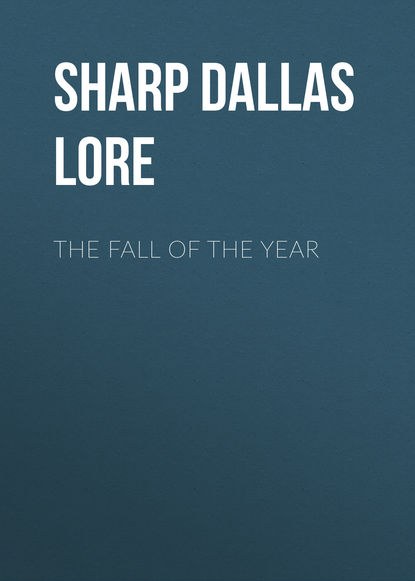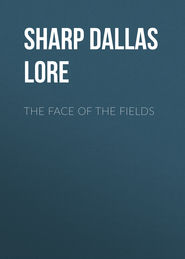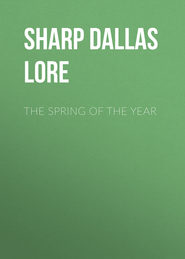По всем вопросам обращайтесь на: info@litportal.ru
(©) 2003-2024.
✖
The Fall of the Year
Настройки чтения
Размер шрифта
Высота строк
Поля
falls a yellow leaf from a slender birch near by … small flock of robins from a pine … swallows were gathering upon the telegraph wires: Next summer, note the exact date on which you first see signs of autumn – the first falling of the leaves, the first gathering of birds for their southern trip. Most of the migrating birds go in flocks for the sake of companionship and protection.
chewink (named from his call, chē-wink´; accent on second, not on first, syllable, as in some dictionaries) or ground robin, or towhee or joree; one of the finch family. You will know him by his saying “chewink” and by his vigorous scratching among the dead leaves, and by his red-brown body and black head and neck.
vireo (vīr´-ē-ō): the red-eyed vireo, the commonest of the vireo family; often called “Preacher”; builds the little hanging nest from a small fork on a bush or tree so low often that you can look into it.
fiery notes of the scarlet tanager (tăn´-a-jẽr): His notes are loud and strong, and he is dressed in fiery red clothes and sings on the fieriest of July days.
Page 4
resonant song of the indigo bunting: or indigo-bird, one of the finch family. He sings from the very tip of a tree as if to get up close under the dome of the sky. Indeed, his notes seem to strike against it and ring down to us; for there is a peculiar ringing quality to them, as if he were singing to you from inside a great copper kettle.
scarlet tanager by some accident: The tanager arrives among the last of the birds in the spring, and builds late; but, if you find a nest in July or August, it is pretty certain to be a second nest, the first having been destroyed somehow – a too frequent occurrence with all birds.
half-fledged cuckoos: The cuckoo also is a very late builder. I have more than once found its eggs in July.
red wood-lily: Do you know the wood-lily, or the “wild orange-red lily” as some call it (Lilium philadelphicum)? It is found from New England to North Carolina and west to Missouri, but only on hot, dry, sandy ground, whereas the turk’s-cap and the wild yellow lily are found only where the ground is rich and moist.
low mouldy moss: Bring to school a flake, as large as your hand, of the kind of lichen you think this may be. Some call it “reindeer moss.”
sweet-fern: Put a handful of sweet-fern (Myrica asplenifolia) in your pocket, a leaf or two in your book; and whenever you pass it in the fields, pull it through your fingers for the odor. Sweet gale and bayberry are its two sweet relatives.
Page 5
milkweed, boneset, peppermint, turtle-head, joe-pye-weed, jewel-weed, smartweed, and budding goldenrod: Go down to the nearest meadow stream and gather for school as many of these flowers as you can find. Examine their seeds.
wind is a sower going forth to sow: Besides the winds what other seed-scatterers do you know? They are many and very interesting.
Page 6
“Over the fields where the daisies grow…”
From “Thistledown” in a volume of poems called “Summer-Fallow,” by Charles Buxton Going.
seed-souls of thistles and daisies and fall dandelions seeking new bodies for themselves in the warm soil of Mother Earth: On your country walks, watch to see where such seeds have been caught, or have fallen. They will be washed down into the earth by rain and snow. If you can mark the place, go again next spring to see for yourself if they have risen in “new bodies” from the earth.
sweet pepper-bush: The sweet pepper-bush is also called white alder and clethra.
chickadees: Stand stock-still upon meeting a flock of chickadees and see how curious they become to know you. You may know the chickadee by its tiny size, its gray coat, black cap and throat, its saying “chick-a-dee,” and its plaintive call of “phœbe” in three distinct syllables.
Page 7
clock strikes twelve: As we have thought of midsummer as the hour from twelve to one in the day, so the dead of winter seems by comparison the twelve o’clock of midnight.
shimmering of the spiders’ silky balloons: It is the curious habit of many of the spiders to travel, especially in the fall, by throwing skeins of silky web into the air, which the breezes catch and carry up, while the spiders, like balloonists, hang in their web ropes below and sail away.
CHAPTER II
TO THE TEACHER
I have chosen the fox in this chapter to illustrate this very interesting and striking fact that wild animals, birds and beasts, thrive in the neighborhood of man if given the least protection; for if the fox holds his own (as surely he does) in the very gates of one of the largest cities in the United States, how easy it should be for us to preserve for generations yet the birds and smaller animals! I might have written a very earnest chapter on the need for every pupil’s joining the Audubon Society and the Animal Rescue League; but young pupils, no less than their elders, hate to be preached to. So I have recounted a series of short narratives, trusting to the suggestions of the chapter, and to the quiet comment of the teacher to do the good work. Every pupil a protector of wild life is the moral.
FOR THE PUPIL
There are two species of foxes in the eastern states – the gray fox, common from New Jersey southward, and the larger red fox, so frequent here in New England and northward, popularly known at Reynard. Far up under the Arctic circle lives the little white or Arctic fox, so valuable for its fur; and in California still another species known as the coast fox. The so-called silver or blue, or black, or cross fox, is only the red fox with a blackish or bluish coat.
Page 9
Mullein Hill: the name of the author’s country home in Hingham, Massachusetts. The house is built on the top of a wooded ridge looking down upon the tops of the orchard trees and away over miles of meadow and woodland to the Blue Hills, and at night to the lights that flash in Boston Harbor. Years before the house was built the ridge was known as Mullein Hill because of the number and size of the mulleins (Verbascum Thapsus) that grew upon its sides and top.
Page 10
mowing-field: a New England term for a field kept permanently in grass for hay.
Page 11
grubby acres: referring to the grubs of various beetles found in the soil and under the leaves of its woodland.
BB: the name of shot about the size of sweet pea seed.
Page 12
Pigeon Henny’s coop: a pet name for one of the hens that looked very much like a pigeon.
shells: loaded cartridges used in a breech-loading gun.
bead drew dead: when the little metal ball on the end of the gun-barrel, used to aim by, showed that the gun was pointing directly at the fox.
Page 16
the mind in the wild animal world: how the animals may really feel when being chased, namely, not frightened to death, as we commonly think, but perhaps cool and collected, taking the chase as a matter of course, even enjoying it.
Page 17
The Chase: The sound of the hunting is likened to a chorus of singing voices; the changing sounds, as when the pack emerges from thick woods into open meadow, being likened to the various measures of the musical score; the whole musical composition or chorus being called The Chase.
Page 18
dead heat: a race between two or more horses or boats where two of the racers come out even, neither winning.
Page 19
Flood: Why spelled with a capital? What flood is meant?
Page 20
hard-pressed fox had narrowly won his way: In spite of the author’s attempt to shoot the fox that was stealing his chickens do you think the author would be glad if there were no foxes in his woods? How do they add interest to his out of doors? What other things besides chickens do they eat? Might it not be that their destruction of woodchucks (for they eat woodchucks) and mice and muskrats quite balances their killing of poultry? (The author thinks so.)
CHAPTER III











